Abstract
The translational efficiency of wheat ribosomes was studied as a function of an in vivo temperature pretreatment of wheat seedlings (Triticum aestivum L.). Ribosomes were isolated from heat-pretreated (36°C) and reference (4°C, 20°C) wheat seedlings. The efficiency of the ribosomes in translating polyuridylic acid was assayed. Ribosomes from heat-pretreated seedlings exhibit a threefold enhanced incorporation rate of phenylalanine as compared to ribosomes from wheat seedlings adapted to 20 or 4°C. This difference develops within 24 hours after onset of the heat treatment of seedlings following a 3 hour lag phase. The temperature induced changes can be traced back to the cytoplasmic ribosomes, since cycloheximide inhibits translation almost completely. Thermal inactivation of ribosomes occurs at 45°C, irrespective of the temperature pretreatment of the wheat seedlings. Specific differences in the yield of ribosomes, in the polyribosomal profiles, and in the apparent Arrhenius' activation energy of protein synthesis were observed depending on the age and the temperature pretreatments. The results presented here are considered an important molecular correlation to phenotypical temperature adaptation of in vivo protein synthesis in wheat (M Weidner, C Mathée, FK Schmitz 1982 Plant Physiol 69: 1281-1288).
Full text
PDF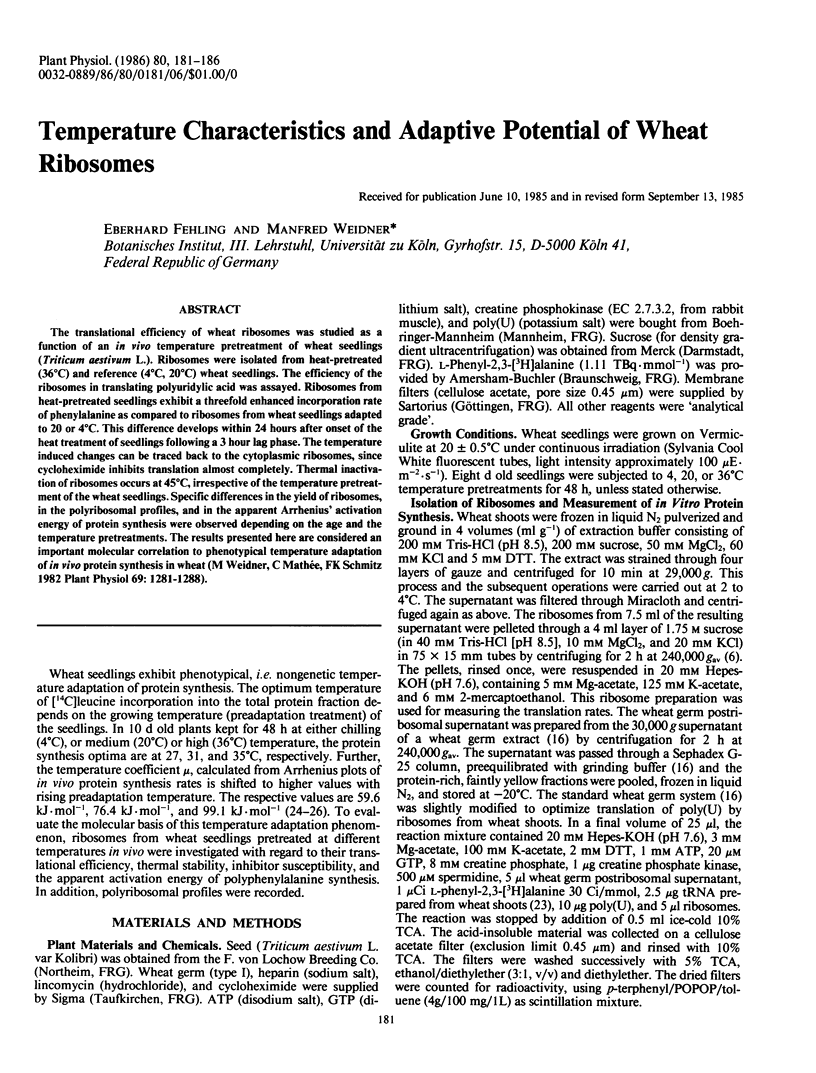

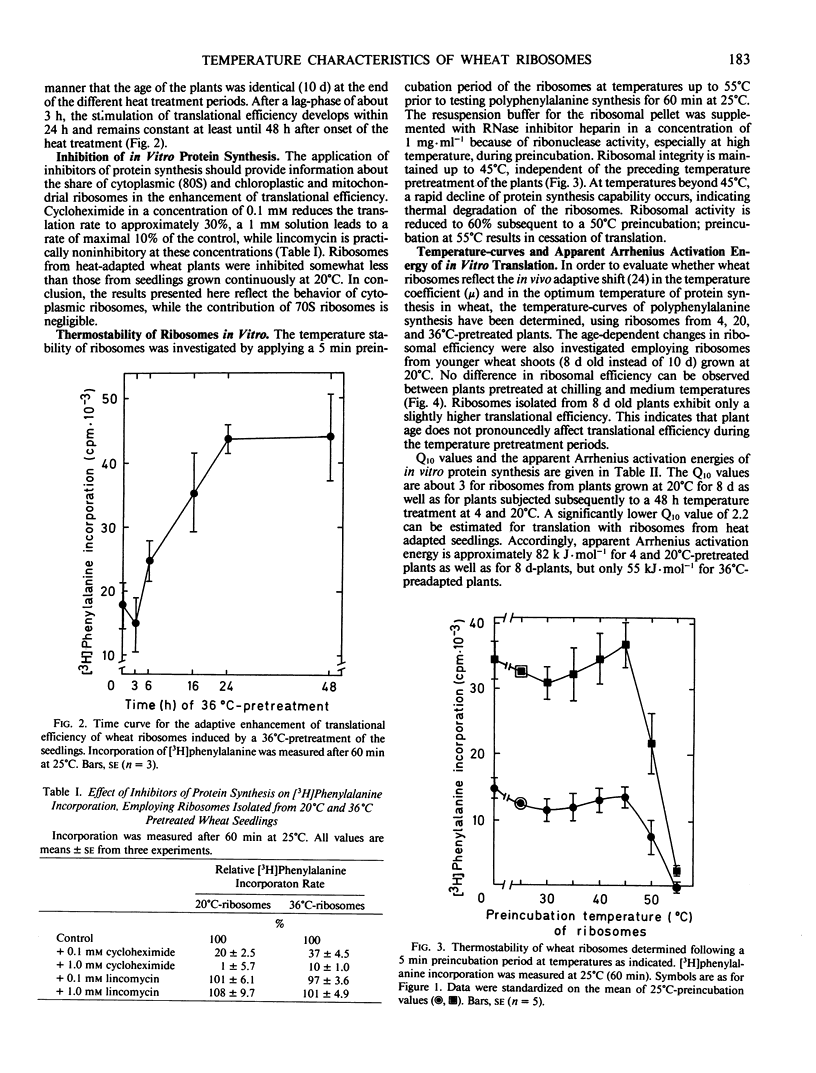
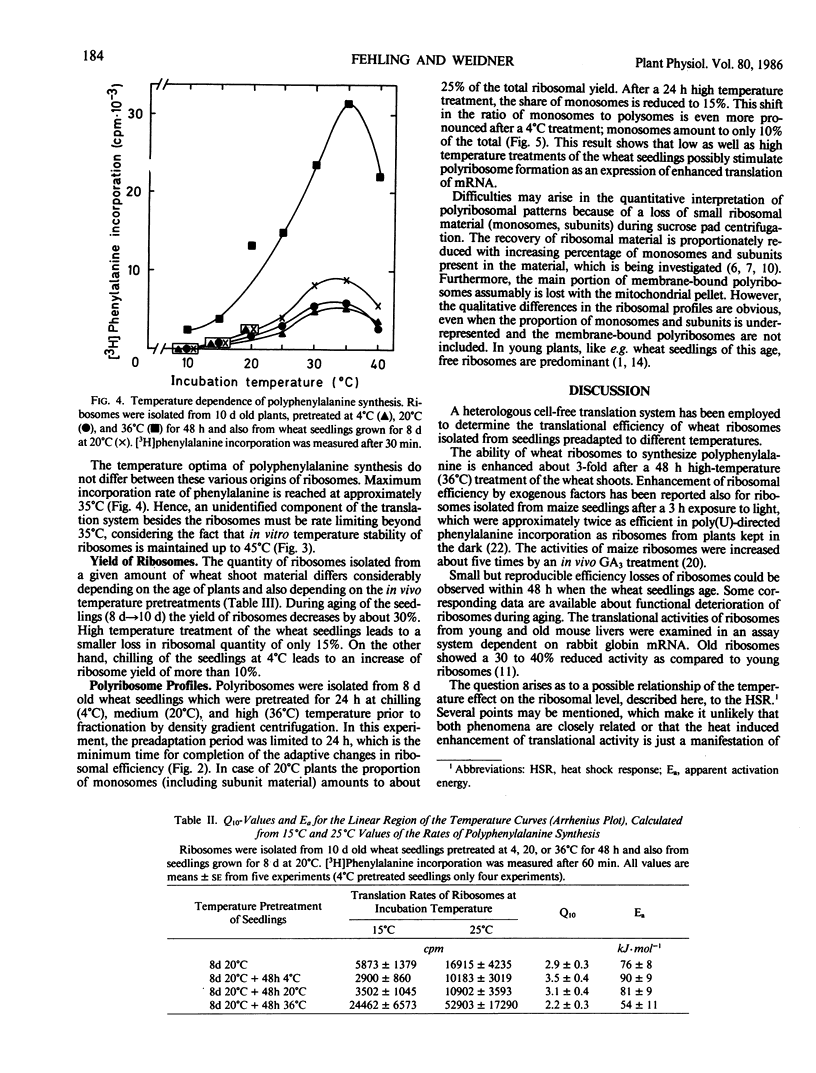
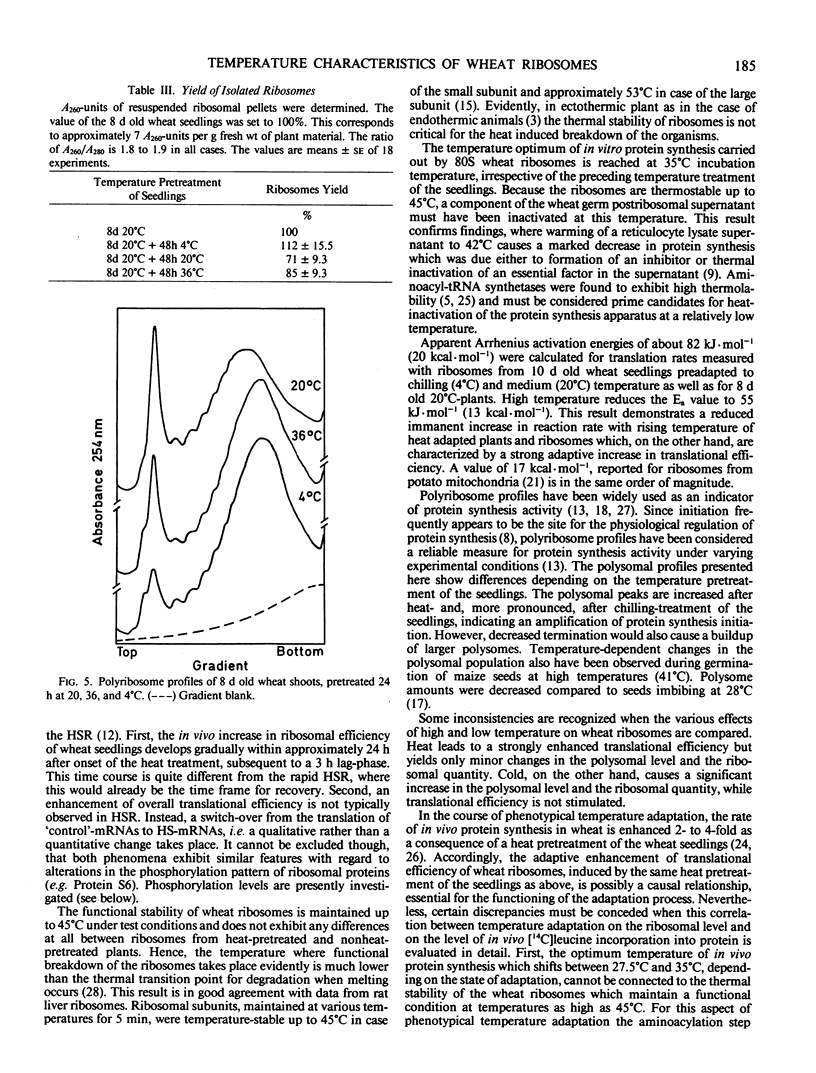
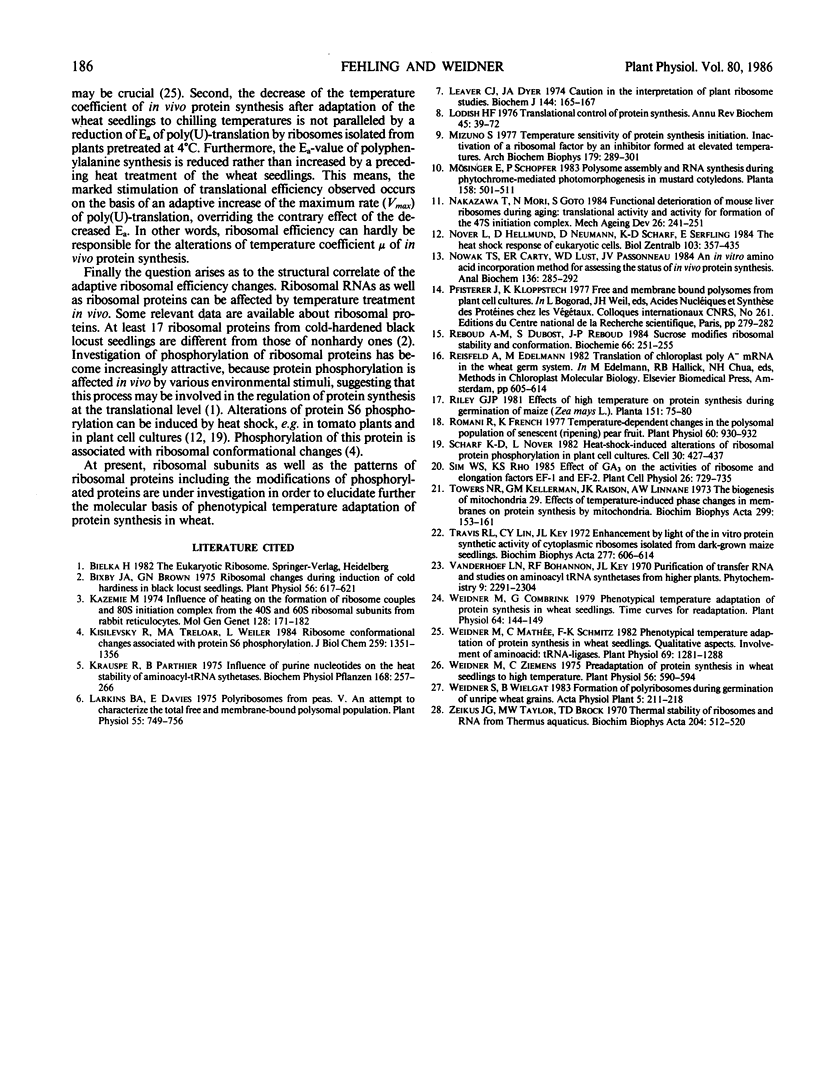
Selected References
These references are in PubMed. This may not be the complete list of references from this article.
- Bixby J. A., Brown G. N. Ribosomal Changes during Induction of Cold Hardiness in Black Locust Seedlings. Plant Physiol. 1975 Nov;56(5):617–621. doi: 10.1104/pp.56.5.617. [DOI] [PMC free article] [PubMed] [Google Scholar]
- Kazemie M. Influence of heating on the formation of ribosome couples and 80S initiation complex from the 40S and 60S ribosomal subunits from rabbit reticulocytes. Mol Gen Genet. 1974;128(2):171–182. doi: 10.1007/BF02654489. [DOI] [PubMed] [Google Scholar]
- Kisilevsky R., Treloar M. A., Weiler L. Ribosome conformational changes associated with protein S6 phosphorylation. J Biol Chem. 1984 Jan 25;259(2):1351–1356. [PubMed] [Google Scholar]
- Larkins B. A., Davies E. Polyribosomes from Peas: V. An Attempt to Characterize the Total Free and Membrane-bound Polysomal Population. Plant Physiol. 1975 Apr;55(4):749–756. doi: 10.1104/pp.55.4.749. [DOI] [PMC free article] [PubMed] [Google Scholar]
- Leaver C. J., Dyer J. A. Caution in the interpretation of plant ribosome studies. Biochem J. 1974 Oct;144(1):165–167. doi: 10.1042/bj1440165. [DOI] [PMC free article] [PubMed] [Google Scholar]
- Lodish H. F. Translational control of protein synthesis. Annu Rev Biochem. 1976;45:39–72. doi: 10.1146/annurev.bi.45.070176.000351. [DOI] [PubMed] [Google Scholar]
- Mizuno S. Temperature sensitivity of protein synthesis initiation. Inactivation of a ribosomal factor by an inhibitor formed at elevated temperatures. Arch Biochem Biophys. 1977 Feb;179(1):289–301. doi: 10.1016/0003-9861(77)90114-x. [DOI] [PubMed] [Google Scholar]
- Nakazawa T., Mori N., Goto S. Functional deterioration of mouse liver ribosomes during aging: translational activity and activity for formation of the 47 S initiation complex. Mech Ageing Dev. 1984 Aug;26(2-3):241–251. doi: 10.1016/0047-6374(84)90097-6. [DOI] [PubMed] [Google Scholar]
- Nowak T. S., Jr, Carty E. R., Lust W. D., Passonneau J. V. An in vitro amino acid incorporation method for assessing the status of in vivo protein synthesis. Anal Biochem. 1984 Feb;136(2):285–292. doi: 10.1016/0003-2697(84)90218-5. [DOI] [PubMed] [Google Scholar]
- Reboud A. M., Dubost S., Reboud J. P. Sucrose modifies ribosomal stability and conformation. Biochimie. 1984 Mar;66(3):251–255. doi: 10.1016/0300-9084(84)90068-3. [DOI] [PubMed] [Google Scholar]
- Romani R., French K. Temperature-dependent Changes in the Polysomal Population of Senescent (Ripening) Pear Fruit. Plant Physiol. 1977 Dec;60(6):930–932. doi: 10.1104/pp.60.6.930. [DOI] [PMC free article] [PubMed] [Google Scholar]
- Scharf K. D., Nover L. Heat-shock-induced alterations of ribosomal protein phosphorylation in plant cell cultures. Cell. 1982 Sep;30(2):427–437. doi: 10.1016/0092-8674(82)90240-9. [DOI] [PubMed] [Google Scholar]
- Towers N. R., Kellerman G. M., Raison J. K., Linnane A. W. The biogenesis of mitochondria 29. Effects of temperature-induced phase changes in membranes on protein synthesis by mitochondria. Biochim Biophys Acta. 1973 Feb 23;299(1):153–161. doi: 10.1016/0005-2787(73)90407-3. [DOI] [PubMed] [Google Scholar]
- Travis R. L., Lin C. Y., Key J. L. Enhancement by light of the in vitro protein synthetic activity of cytoplasmic ribosomes isolated from dark-grown maize seedlings. Biochim Biophys Acta. 1972 Sep 14;277(3):606–614. doi: 10.1016/0005-2787(72)90105-0. [DOI] [PubMed] [Google Scholar]
- Weidner M., Combrink G. Phenotypical temperature adaptation of protein synthesis in wheat seedlings: time curves for readaptation. Plant Physiol. 1979 Jul;64(1):144–149. doi: 10.1104/pp.64.1.144. [DOI] [PMC free article] [PubMed] [Google Scholar]
- Weidner M., Mathée C., Schmitz F. K. Phenotypical Temperature Adaptation of Protein Synthesis in Wheat Seedlings : QUALITATIVE ASPECTS. INVOLVEMENT OF AMINOACID:tRNA-LIGASES. Plant Physiol. 1982 Jun;69(6):1281–1288. doi: 10.1104/pp.69.6.1281. [DOI] [PMC free article] [PubMed] [Google Scholar]
- Weidner M., Ziemens C. Preadaptation of protein synthesis in wheat seedlings to high temperature. Plant Physiol. 1975 Nov;56(5):590–594. doi: 10.1104/pp.56.5.590. [DOI] [PMC free article] [PubMed] [Google Scholar]
- Zeikus J. G., Taylor M. W., Brock T. D. Thermal stability of ribosomes and RNA from Thermus aquaticus. Biochim Biophys Acta. 1970 Apr 15;204(2):512–520. doi: 10.1016/0005-2787(70)90171-1. [DOI] [PubMed] [Google Scholar]


